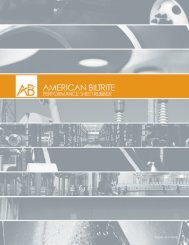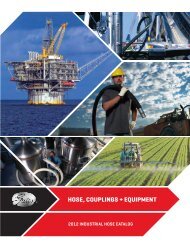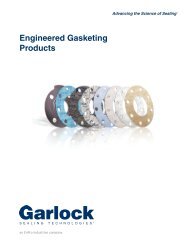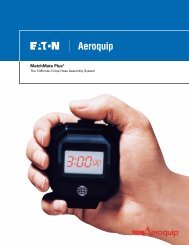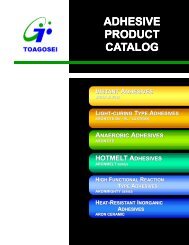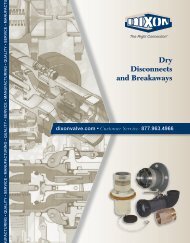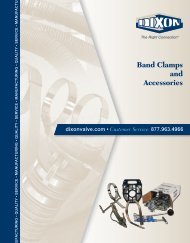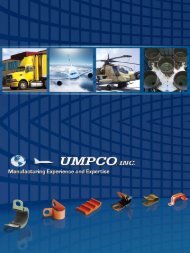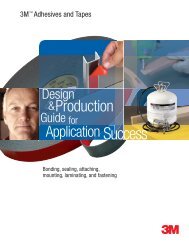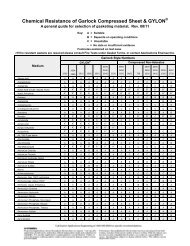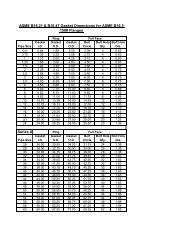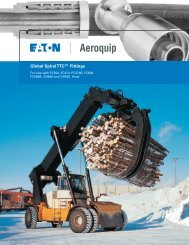Kuri-Tec tubing and hose - Kuriyama of America
Kuri-Tec tubing and hose - Kuriyama of America
Kuri-Tec tubing and hose - Kuriyama of America
You also want an ePaper? Increase the reach of your titles
YUMPU automatically turns print PDFs into web optimized ePapers that Google loves.
®<br />
leak resistance without risk <strong>of</strong> damage to the core tube<br />
or deterioration <strong>of</strong> the yarn reinforcement due to wicking.<br />
Hose failure near a fitting<br />
A <strong>hose</strong> is most susceptible to failure near the fitting. The<br />
installation <strong>of</strong> the fitting involves some risk <strong>of</strong> damage to<br />
the core tube. There is also some possibility <strong>of</strong> slight<br />
leakage along a fitting <strong>and</strong> subsequent yarn wicking,<br />
particularly if a one-piece crimped fitting is used. The<br />
greatest amount <strong>of</strong> flexing <strong>of</strong>ten occurs near the fitting at<br />
either the supply or service end <strong>of</strong> the <strong>hose</strong>.<br />
In the investigation <strong>of</strong> a <strong>hose</strong> failure near the fitting, it<br />
is essential that the fitting/<strong>hose</strong> interface be examined.<br />
In the field, if the failure or deterioration is isolated to<br />
the area near the fitting, it is best to cut <strong>of</strong>f the end <strong>of</strong><br />
the <strong>hose</strong>, reinstall a new fitting, <strong>and</strong> monitor the <strong>hose</strong> in<br />
service to see if the problem reoccurs.<br />
If the problem involves a spray <strong>hose</strong> <strong>and</strong> fluid slowly<br />
leaking through the cover perforations near the fitting,<br />
the most likely cause is wicking along the reinforcing<br />
yarn from the end <strong>of</strong> the <strong>hose</strong> or from a cut or break in<br />
the core tube. Such wicking can extend over several feet<br />
<strong>and</strong> a leak may be seen at a considerable distance from<br />
the source <strong>of</strong> the leak.<br />
If a <strong>hose</strong> is being returned to the supplier for investigation<br />
<strong>of</strong> a failure, it is essential that the fitting . . . or at<br />
least the section <strong>of</strong> <strong>hose</strong> in contact with the fitting . . . be<br />
returned. Only by examining the inner surface <strong>of</strong> the tube<br />
that was in contact with the fitting can one determine<br />
with certainty if the problem began at the fitting.<br />
WARNING<br />
The above comments <strong>and</strong> fitting suggestions are intended<br />
for use as guidelines only. The information provided is<br />
based on tests which we believe to be reliable <strong>and</strong> on<br />
our past observations <strong>and</strong> experience. No warranty is<br />
expressed or implied, as applications <strong>and</strong> methods <strong>of</strong><br />
fitting installation can vary widely. Before placing a <strong>hose</strong><br />
in service, the user must determine the suitability <strong>of</strong> the<br />
fitting <strong>and</strong> <strong>hose</strong>/tube for his or her intended use. The<br />
user assumes all risk <strong>and</strong> liability resulting from the use<br />
<strong>of</strong> any <strong>Kuri</strong> <strong>Tec</strong> product with any fitting whatsoever.<br />
FITTING SUGGESTIONS<br />
Temperature Dependence <strong>of</strong> Pressure Rating<br />
As a general rule, the working pressure ratings for<br />
plastic reinforced <strong>hose</strong>s are based on room temperature<br />
conditions. The maximum allowable pressure for a <strong>hose</strong><br />
decreases as the temperature increases <strong>and</strong> the material<br />
becomes s<strong>of</strong>ter <strong>and</strong> more elastic. Fitting retention<br />
decreases at higher temperatures as the compression on<br />
the material declines.<br />
Working pressure ratings can be affected significantly by<br />
the type <strong>of</strong> fitting used, the method <strong>of</strong> attachment, <strong>and</strong><br />
the temperature to which the <strong>hose</strong> assembly is exposed<br />
in service. Repeated intermittent periods <strong>of</strong> exposure<br />
to elevated temperatures can affect fitting retention<br />
<strong>and</strong> it is, therefore, very difficult to assign working<br />
pressure ratings at high temperatures. The graph below<br />
demonstrates the overall trend.<br />
Burst strength<br />
decreases as<br />
temperature<br />
increases<br />
Working Pressure Ratings<br />
Working pressure ratings are given in this catalog at 70°F No warranty is expressed or implied, as applications<br />
<strong>and</strong> 122°F. Between 122°F <strong>and</strong> the maximum service <strong>and</strong> methods <strong>of</strong> fitting installation may vary widely.<br />
temperature, it must be noted that a rapid decline in the Before placing a <strong>hose</strong> in service, the user must<br />
pressure rating <strong>of</strong> the <strong>hose</strong> may occur, <strong>and</strong> all factors determine the suitability <strong>of</strong> the product under the correct<br />
relating to the <strong>hose</strong>, fittings <strong>and</strong> service conditions must working conditions, <strong>and</strong> assumes all risk <strong>and</strong> liability in<br />
be taken into consideration.<br />
connection therewith.<br />
Please refer to the back page for the location <strong>of</strong> your nearest warehouse for availability <strong>of</strong> products/sizes shown.<br />
Because we continually examine ways to improve our products, we reserve the right to alter specifications OR DISCONTINUE PRODUCTS without prior notice.<br />
KKTCA0408<br />
65




